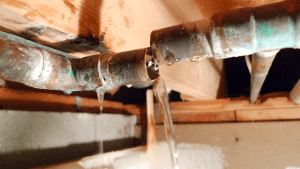Guide To Water Leak Discovery In The House
Guide To Water Leak Discovery In The House
Blog Article
We have noticed this great article pertaining to Top leak detection hacks down the page on the web and figured it made perfect sense to share it with you over here.

Early discovery of leaking water lines can minimize a prospective disaster. Some little water leaks might not be visible.
1. Check Out the Water Meter
Every home has a water meter. Examining it is a guaranteed way that aids you discover leakages. For starters, shut off all the water resources. Make sure no person will purge, use the tap, shower, run the washing maker or dishwasher. From there, go to the meter and watch if it will transform. Because no person is using it, there must be no activities. If it moves, that shows a fast-moving leak. Also, if you identify no changes, wait an hour or 2 and inspect back once more. This implies you might have a slow-moving leak that could also be below ground.
2. Check Water Usage
If you identify abrupt adjustments, regardless of your intake being the very same, it suggests that you have leakages in your plumbing system. An abrupt spike in your costs shows a fast-moving leakage.
A steady increase every month, also with the very same routines, reveals you have a sluggish leak that's also gradually rising. Call a plumber to completely inspect your home, particularly if you feel a cozy location on your flooring with piping beneath.
3. Do a Food Coloring Test
When it involves water intake, 30% originates from toilets. Test to see if they are running correctly. Decline specks of food color in the storage tank and wait 10 minutes. If the shade somehow infiltrates your dish during that time without flushing, there's a leak in between the storage tank and also dish.
4. Asses Exterior Lines
Do not fail to remember to examine your outdoor water lines as well. Should water seep out of the connection, you have a loosened rubber gasket. One little leak can lose bunches of water as well as surge your water costs.
5. Inspect as well as Assess the Scenario
Home owners ought to make it a routine to examine under the sink counters and also even inside cabinets for any type of bad odor or mold development. These 2 warnings show a leak so prompt attention is needed. Doing routine assessments, also bi-annually, can conserve you from a significant trouble.
More importantly, if you know your house is already old, keep a watchful eye on your heating units, pipes, pipelines and so on. Check for discolorations and compromising as many pipes as well as appliances have a life span. They will certainly likewise naturally deteriorate due to tear and also put on. If you believe dripping water lines in your plumbing system, do not wait on it to intensify. Call an expert plumber as soon as possible so you don't end up with a terrible mess in your house.
Early discovery of leaking water lines can mitigate a possible catastrophe. Some tiny water leakages might not be visible. Examining it is a guaranteed way that aids you find leaks. One little leak can lose lots of water and increase your water expense.
If you suspect dripping water lines in your plumbing system, don't wait for it to rise.
WARNING SIGNS OF WATER LEAKAGE BEHIND THE WALL
PERSISTENT MUSTY ODORS
As water slowly drips from a leaky pipe inside the wall, flooring and sheetrock stay damp and develop an odor similar to wet cardboard. It generates a musty smell that can help you find hidden leaks.
MOLD IN UNUSUAL AREAS
Mold usually grows in wet areas like kitchens, baths and laundry rooms. If you spot the stuff on walls or baseboards in other rooms of the house, it’s a good indicator of undetected water leaks.
STAINS THAT GROW
When mold thrives around a leaky pipe, it sometimes takes hold on the inside surface of the affected wall. A growing stain on otherwise clean sheetrock is often your sign of a hidden plumbing problem.
PEELING OR BUBBLING WALLPAPER / PAINT
This clue is easy to miss in rooms that don’t get much use. When you see wallpaper separating along seams or paint bubbling or flaking off the wall, blame sheetrock that stays wet because of an undetected leak.
BUCKLED CEILINGS AND STAINED FLOORS
If ceilings or floors in bathrooms, kitchens or laundry areas develop structural problems, don’t rule out constant damp inside the walls. Wet sheetrock can affect adjacent framing, flooring and ceilings.
https://www.servicemasterbyzaba.com/blog/how-to-detect-water-leakage-in-walls/

As a devoted person who reads on Top leak detection hacks, I imagined sharing that blog post was sensible. Sharing is good. You just don't know, you might be helping someone out. We thank you for reading our article about Finding hidden leaks.
Report this page